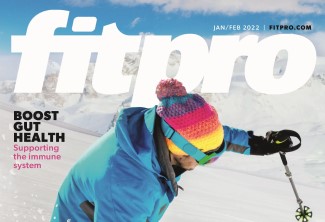Magazine References
Jan – Feb 2022

Pg 6-8 Fitness could start in the home
References
- Active Lives Adult Survey, May 2020/21 Report. Published October 2021.
- Brown W et al (2012), Occupational and household activities are important for energy expenditure, but sport and recreation remain the best buy for public health, British Journal of Sports Medicine, 48. doi: 10.1136/bjsports-2011-090992
- Jitnarin N et al (2011), Prevalence of overweight and obesity in Thai population: Results of the National Thai Food Consumption Survey, Eat Weight Disord., 16(4): 242-249.
- Zheng W et al (2005), The Shanghai Women’s Health Study: rationale, study design, and baseline characteristics, Am J Epidemiol, 162(11): 1,123-31.
- 1. Padmaja R et al (2019), Understanding nutritional outcomes through gendered analysis of time-use patterns in semi-arid India Global Food Security, 23: 49-63.
- Batman and Markham, METex: Converting Heart Rates to Metabolic Equivalents. In Press
Pg 14-15 How to support a healthy immune system through your gut
References
- Rooks et al (2016), Gut microbiota, metabolites and host immunity, Nat Rev Immunol., 16(6): 341-52.
- Levy et al (2017), Dysbiosis and the immune system, Cell, 17(4): 219-32.
- Wastyk et al (2021), Gut-microbiota-targeted diets modulate human immune status, Cell, 184(16): 4,137-53.e14.
- Makki et al (2018), The impact of dietary fiber on gut microbiota in host health and disease, Cell Host Microbe, 13: 23.
- Zmora et al (2017), You are what you eat: diet, health and the gut microbiota, Nat Rev Gastoenterol Hepatol.,16.
- Singh R (2017), Influence of diet on the gut microbiome and implications for human health, J Transl Med., 73.
- Shen T (2017), Diet and gut microbiota in health and disease, Nestle Nut Inst Workshop Ser., 88: 117-26.
- Ma N et al, Contributions of the interaction between dietary protein and gut microbiota to intestinal health, Curr Protein Pept Sci., 795-808.
Pg 18-20 Get your clients snow fit
References
- Koller et al (2015), Decrease in eccentric quadriceps and hamstring strength in recreational alpine skiers after prolonged skiing,
https://www.ncbi.nlm.nih.gov/pmc/articles/PMC5117052/, accessed 2 November 2021. - www.ebfa.com: https://barefootstrongblog.com/2021/09/13/3-steps-to-a-stronger-foot-core-connection/
https://barefootstrongblog.com/2016/02/02/myofascial-energy-transfer-movement-efficiency/
https://www.youtube.com/watch?v=CWvCcsiRu6k, accessed 2 November 2021. - Aagaard et al (1998), Tourny-Chollet & Leroy (2002), H: Q ratios in open versus closed kinetic chain: what is the relevance for alpine ski racers?, accessed 2 November 2021.
Pg 22-25 The not-so-special populations
References
- https://www.kernowccg.nhs.uk/your-health/long-term-conditions/, accessed on 16 November 2021.
- https://digital.nhs.uk/data-and-information/publications/statistical/health-survey-for-england/2019/health-survey-for-england-2019-data-tables, accessed on 16 November 2021.
- https://www.gov.uk/government/publications/chief-medical-officers-annual-report-2020-health-trends-and-variation-in-england, accessed on 16 November 2021.
- https://gov.wales/national-survey-wales, accessed on 16 November 2021.
- https://www.gov.scot/collections/scottish-health-survey/, accessed on 16 November 2021.
- https://www.cntw.nhs.uk/content/uploads/2017/12/HS-PGN-14-App9-Irwin-Morgan-RiskStratTool-V02-Iss-2-Oct-19.pdf, accessed on 16 November 2021.
- https://www.gov.uk/government/publications/health-matters-physical-activity/health-matters-physical-activity-prevention-and-management-of-long-term-conditions, accessed on 16 November 2021.
- https://movingmedicine.ac.uk/consultation-guides/patient-info-finder/?p=adult&c=msk-pain, accessed on 16 November 2021.
- https://www.gov.uk/government/publications/physical-activity-guidelines-uk-chief-medical-officers-report, accessed on 16 November 2021.
- https://www.who.int/publications/i/item/9789240015128, accessed on 16 November 2021.
- https://evidence.nihr.ac.uk/collection/making-sense-of-the-evidence-multiple-long-term-conditions-multimorbidity/, accessed on 16 November 2021.
- https://www.acsm.org/read-research/trending-topics-resource-pages/physical-activity-guidelines, accessed on 16 November 2021.
- https://evaluationframework.sportengland.org/ (update due December 2021), accessed on 16 November 2021.
- Kanamori S <itals>et al</itals> (2016), ‘Exercising alone versus with others and associations with subjective health status in older Japanese: The JAGES Cohort Study,’ Scientific reports, 6: 39151, doi:10.1038/srep39151
- American College of Sports Medicine, Physical activity guidelines, https://www.acsm.org/read-research/trending-topics-resource-pages/physical-activity-guidelines, accessed on 16 November 2021.
- Sport England Evaluation Framework, https://evaluationframework.sportengland.org/ (update due December 2021), accessed on 16 November 2021.
- Exercise Referral Toolkit https://www.ncsem-em.org.uk/get-active/exercise-referral-toolkit/
Pg 26-27 Access all areas: How inclusive is your fitness facility?
References
- http-s://www.aihw.gov.au/reports/disability/people-with-disability-in-australia/contents/health/chronic-conditions-and-disability, accessed on 26 October 2021.
Pg 32-35 Medicine ball training: An under-utilised tool for developing explosive strength
References
- Suchomel TJ, Nimphius S, Stone MH (2016), The importance of muscular strength in athletic performance, Sports Medicine, 46(10): 1 419-49.
- Wing CE, Turner AN, Bishop CJ (2020), Importance of strength and power on key performance indicators in elite youth soccer, The Journal of Strength & Conditioning Research, 34(7): 2,006-14.
- Sommerfield LM, Harrison CB, Whatman CS, & Maulder PS (2020), Relationship between strength, athletic performance, and movement skill in adolescent girls, Journal of Strength and Conditioning Research.
- Cormie P, McGuigan MR, Newton RU (2011), Developing maximal neuromuscular power, Sports Medicine, 41(1): 17-38.
- Suchomel TJ, Nimphius S, Bellon CR, Stone MH (2018), The importance of muscular strength: Training considerations, Sports Medicine, 48(4): 765-85.
- Haff GG, Nimphius S (2012), Training principles for power, Strength & Conditioning Journal, 34(6): 2-12.
- Kraemer WJ, Newton RU (2000), Training for muscular power, Physical Medicine and Rehabilitation Clinics of North America, 11(2): 341-68.
- Baker D, Broncos SC (2007), Using full acceleration and velocity-dependant exercises to enhance power training, Strength and Conditioning Coach, 15(2): 16.
- Clark RA, Bryant AL, Humphries B (2008), A comparison of force curve profiles between the bench press and ballistic bench throws, The Journal of Strength & Conditioning Research, 22(6): 1,755-59.
- Earp JE, Kraemer WJ (2010), Medicine ball training implications for rotational power sports, Strength & Conditioning Journal, 32(4): 20-5.
- Galay VS, Poonia R, Singh M (2021), Understanding the significance of plyometric training in enhancement of sports performance: a systematic review, Vidyabharati International Interdisciplinary Research Journal, 11(2): 141-8.
- Schmidtbleicher D (1992), Training for power events, Strength and Power in Sport, 1: 381-95.
- Cormier P, Freitas TT, Rubio-Arias JÁ, Alcaraz PE (2020), Complex and contrast training: Does strength and power training sequence affect performance-based adaptations in team sports? A systematic review and meta-analysis, The Journal of Strength & Conditioning Research, 34(5): 1,461-79.
- Talpey SW, Young WB, Saunders N (2014), The acute effects of conventional, complex, and contrast protocols on lower-body power, The Journal of Strength & Conditioning Research, 28(2): 361-6.
- Maestroni L, Read P, Bishop C, Turner A (2020), Strength and power training in rehabilitation: Underpinning principles and practical strategies to return athletes to high performance, Sports Medicine, 50(2): 239-52.
- Lonergan BM, Tallent J, Lazarczuk S (2018), Needs analysis of mixed martial arts, Journal of Australian Strength and Conditioning, 26(5).
- Ratamess NA (2011), Strength and conditioning for grappling sports, Strength & Conditioning Journal, 33(6): 18-24.
- Dal Bello F, Brito CJ, Amtmann J, Miarka B (2019), Ending MMA combat, specific grappling techniques according to the type of the outcome, Journal of Human Kinetics, 67: 271.
- La Bounty P, Campbell BI, Galvan E, Cooke M, Antonio J (2011), Strength and conditioning considerations for mixed martial arts, Strength & Conditioning Journal, 33(1): 56-67.
- Demirkan E, Ünver R, Kutlu M, Mitat KO (2012), The comparison of physical and physiological characteristics of junior elite wrestlers, Beden Eğitimi ve Spor Bilimleri Dergisi., 6(2): 138-44.
- Kim J, Cho HC, Jung HS, Yoon JD (2011), Influence of performance level on anaerobic power and body composition in elite male judoists, The Journal of Strength & Conditioning Research, 25(5): 1,346-54.


